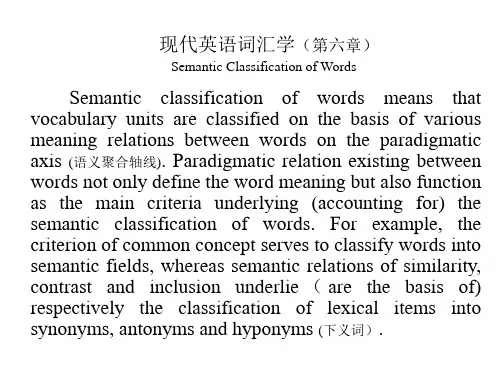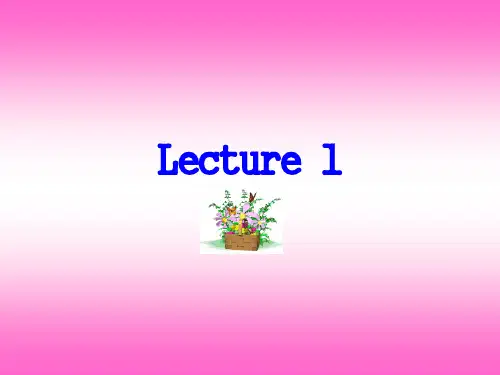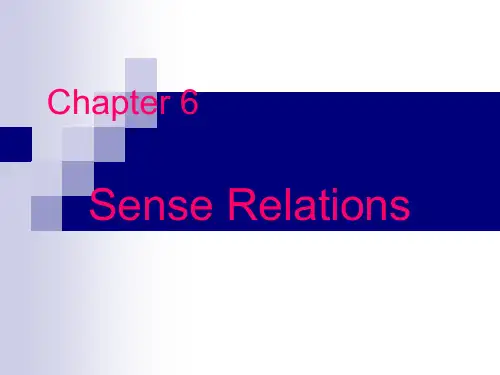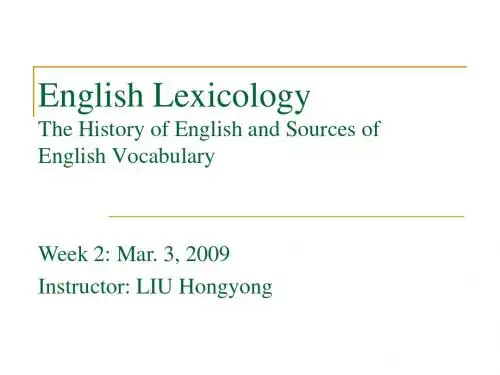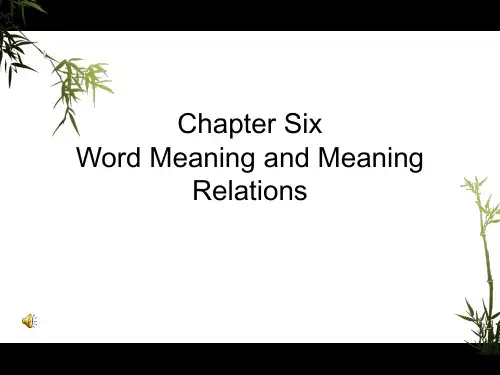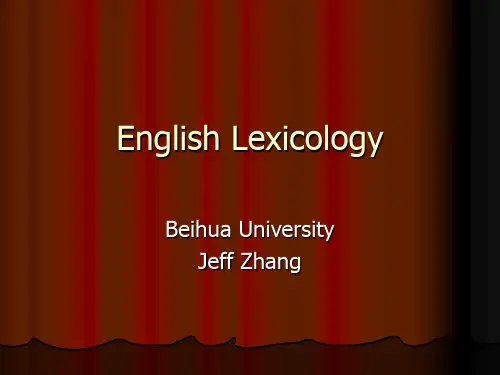英语词汇学教程课件第6章English Lexicology 6上
- 格式:ppt
- 大小:522.50 KB
- 文档页数:22
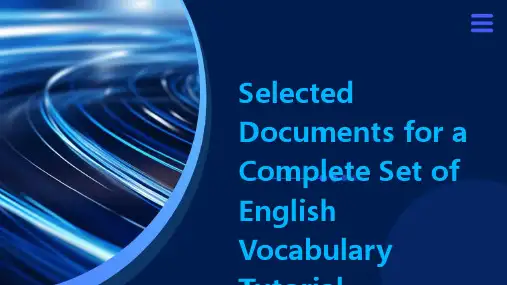
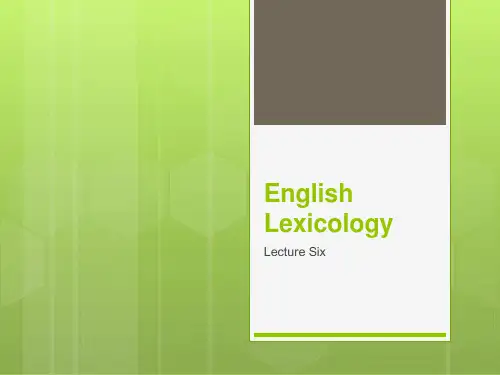
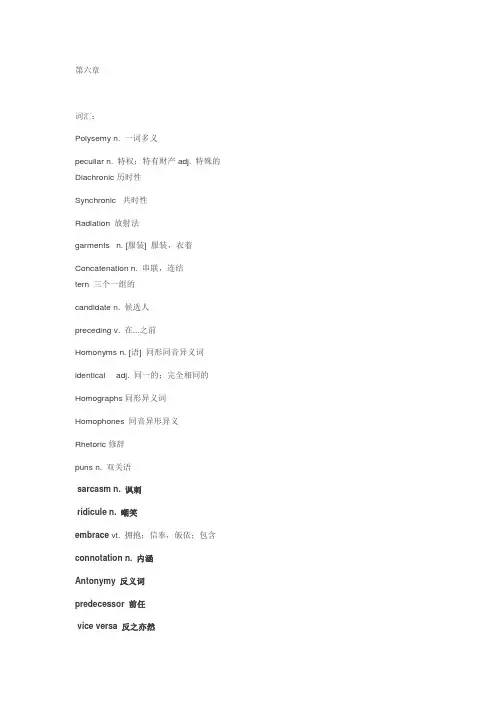
第六章词汇:Polysemy n. 一词多义peculiar n. 特权;特有财产adj. 特殊的Diachronic 历时性Synchronic 共时性Radiation 放射法garments n. [服装] 服装,衣着Concatenation n. 串联,连结tern 三个一组的candidate n. 候选人preceding v. 在...之前Homonyms n. [语] 同形同音异义词identical adj. 同一的;完全相同的Homographs同形异义词Homophones 同音异形异义Rhetoric 修辞puns n. 双关语sarcasm n. 讽刺ridicule n. 嘲笑embrace vt. 拥抱;信奉,皈依;包含connotation n. 内涵Antonymy 反义词predecessor 前任vice versa 反之亦然Hyponymy 上下位关系要点一. 1.Polysemy—polysemy is a common feature peculiar to all natural languages. When a words is first coined, it always monosemic, butin the course of development , the same word may have two or more different meanings.e.g. The word "flight" may mean "passing through the air", "power of flying", "air of journey", etc.2.Two approaches1).( Diachronic approach –Diachronically, polysemy is assumed to be the result of growth and development ofthe semantic structure of one and same word.This first meaning is the primary meaning. With the advance of timeand the development of language, it took on more and more meanings. These latter meanings are called derived meanings.E.g. faceThe primary meaning gave birth to new meaning.The primary meaning become either absolute or disappeared altogetherE.g. harvesttime of cutting reaping and gathering the cropsa season‘s yield of grain or fruitPain penalty or punishment pains and penaltyupon/under pain of suffering2).Synchronic approach –synchronically, polysemy is viewed as the coexistent of various meaning of the same word in a certain historical period of time.The basic meaning of a word is the core of word meaning.The core of word meaning called the central meaning (secondary meaning).The central meaning has gradually dimished in currency with the changes and one ofthe derived meanings has become dominant.E.g. gay3.Two process of development1). Radiation-a semantic process which shows that the primary meaning stands at the center and each of the derived meanings proceed out of in every direction like rays.The meanings are independent of one another, but can all be tracked back to thecentral meaning.e.g. Neck1) That part of a man or animal jointing the head to the body2) That part of the garments3) The neck of an animal used as food4) A narrow part between the head and body or base of any object5) The part of anythingOf the 5 meanings 1) is the primary and all the rest are derived but each of the otherfour is directly related to 1).Therefore, we say neck has developed through the process of radiation.2).Concatenation –meaning ―linking together, is the semantic process in which the meaning of a word moves gradually away from its first sense by successive shifts until,in many cases, there is not a sign of connectionbetween the sense that is finally developed and that which the term hadat the begining.e.g. candidate1) White-robed adj. 穿白色长袍的2) Office seeker in white gouns3) A person who seeks an office4) A person proposed for a place, award, etc.Of the 4 meanings, 1) is the primary meaning and the other three are derived, but each of the derived meaning isonly directly related to the preceding one and there is no direct connection between 1) and 4). Therefore, we saycandidate has developed through the process of concatenation.3).DifferenceRadiation and concatenation is closely related, being different stages of thedevelopment leading to polysemy.Radiation, each of the derived meaning is directly connected to the primary meaning.Concatenation, each of the later meaning is related only to the preceding one likechains. Though the latest sensecan be tracked to the original, there‘s no direct connection in between.The two processes work together, complementing each other.Radiation precedes concatenation.1.Homonyms--are generally defined as words different in meaning but either identical both i n s ound and spellingor identical only in sound or spelling.2.1).Perfect Homonyms--are words identical both in sound and spelling, but different in meaning.e.g. bank/bank ,bear/bear ,date/date2).Homographs--are words identical only in spelling but different in sound and meaning.e.g. Bow/bow ,Sow/sow3).Homophones (most common)--are words identical only in sound but different in spelling a nd meaning.e.g. Dear/dear ,Right/rite ,Son/sun3.Origins of Homonyms1). Change in sound and spelling(homonyms are native by origin, derived from different earlier forms in OldEnglish. The change in sound and spelling gradually made them identical in modernEnglish.)e.g. ear/ear ,long/long2). Borrowing (many words of foreign origin coincide in sound and/or spelling withthose of native origin with those of other foreign origin.)e.g. fair/fair,ball/ball3). Shortening (many shortened forms of words happen to be identical with otherwords in spelling or sound)e.g. ad/add,rock/rock ,NOW/now4.Differentiation of Homonyms and polysemants(Perfect homonyms and polysemants are fully identical regard to spelling and pronunciation. )Homonyms refer to different word, which happen to share the same forms.Polysemant is the one and some word, which has several meanings.1).One important criterion is to see their etymology. Homonyms are from differen tsources. A polysemant is from the same source,which has acquired different meaning in the course of development.2). The second principle is semantic relatedness.The various meanings of a polysemant are correlated andconnected to some central meaning to a greater or less degree. Meanings of different homon yms have nothing to do with one another.5.Rhetoric featureThey create puns for desired effect of, say, humour, sarcasm or ridicule.三.1.Synonyms—are words different in sound and spelling but most nearly alike or exactly the same in mean ing.Synonyms share a likeness in denotation and in part of speech.2.Types of Synonyms1).Absolute (Complete) Synonyms--are words, which are identical in meaning inall its aspects, both in grammatical meaning and lexical meaning,including c onceptual and associative meanings.Absolute (Complete) Synonyms are restricted to high-specialized vocabulary.For instance, composition / compounding. They have the perfect same meaningin Lexicology.2).Relative (Near) synonyms--are similar or nearly the same in denotation but embrace different shades of meaning or different degrees of a given quality.e.g. Change/alter/varyTake stagger/reel/totter for example.Stagger implies unsteady movement characterized by a loss of balance and failure to maintai n a fixed course.E.g. stagger under a heavy load;Reel suggests a swaying or lurching so as to appear on the verge of falling.E.g. The drunken man reeled down the hall;Totter indicates the uncertain, faltering steps of a feeble old person or of an infant learning to walk.3.Sources of Synonyms1).Borrowing: (the most important source)2).Dialects and regional English:eg.Railway (BrE) railroad (AmE)Mother (BrE) minny (ScotE)Charm (BrE) glamour (ScotE)Ranch (AmE) run (AusE)Job (StandE) gig (BlackE)Jim (BlachE) mal person (StandE)3).Figurative a. 比喻的,象征的and euphemistic a.委婉的use of words:Occupation walk of life (fig.)Dreamer star-gazer (fig.)Drunk elevated (euph.)Lie distort the fact (euph.)4).Coincidence with idiomatic expressions:Win gain the upper handDecide make up one‘s mindFinish get throughHesitate be in two mindsHelp lend one a hand4.Discrimination of Synonyms1) Difference in denotation: differ in the range and intensity of meaning.Range (some words have a wider range of meaning than others)e.g. timid--timorousTimid is applied to the state of minds in which a person may happen to be at the moment, ant to the habitual disposition.Timorous is only to the disposition.Comprehend/ understandextend—increase—expandThe owner of the restaurant is going to extend the kitchen by ten feet this year. The company has decided to increase its sales by ten percent next year.The metal will expand if heated.Extent increase expand Differ in degree of intensitye.g. wealth—richThe wealth person is to posses more money and property than a rich man.work – toilWork is a general term having no special implications as ‗light‘ or ‗heavy‘, and‗mental‘ or ‗physical‘.Toil suggests ‗heavy and tiring work‘, associated with more with manual thanmental labor.want—wish—desireWant is the most general and has the widest range of meaning.Wish and desire are much narrow in sense2) Difference in connotation: differ in the stylistic and emotive coloring.Some words share the same denotation but differ in their stylistic appropriateness.E.g. The words borrowed from French and Latin are more formal than native words.These borrowings are more appropriate formal and technical writing.policeman – constable – bobby – coppoliceman(neutral) – constable(neutral) – bobby(colloquial) – cop(slangy)ask -- beg -- requestask (neutral); beg (colloquial); request (formal)archaic and poetic, which are self-suggestive.e.g.ire/anger,bliss/happiness,forlorn/distressed,dire/dreadful,list/listen,enow/enough,save/exp ect,mere/lake andsuch like are all synonyms, but in each the second is standard in usage whereas the first on e is old-fashioned and archaic, only found in poetry, earlier writing, etc.Many synonyms have clear affective valuesresult – consequence result(neutral ) – consequence(negative implication)big –greatbig(the bigness of size, volume and so on, without any emotive coloring) -great(suggest distinguished, eminent, outstanding)little – small – tinylittle (attractiveness, pleasantness)– small(not big),tiny(abnormal growth of the child)3) Difference in application: differ in usage.Many words are synonyms in meaning but different in usage in simple terms.They form different collocations and fit into different sentence patterns.E.g. allow – letallow sb to so sth. – let sb. do sth.answer – replyanswer(transitive v.) the letter – reply(intransitive v.) to the lettersense –meaningHe is a man of sense.empty -- vacantempty box/street/room (no one or nothing inside) vacant seat/chair/apartment(not occupied) lump –slice – chunk – sheet –cakea lump sugar– a slice of meat – a chunk of wood – a sheet of paper –a cake of soap四.1.Antonymy--is concerned with semantic opposition.Antonyms--are words which are opposite in meaning.2.Types of Antonyms (according to the semantic opposition )1) Contradictory terms –these antonyms are truly represent oppositeness of meaning. They are so opposed toeach other that they are mutually exclusive and admit no possibility between them.They assertion of one is the denial of the other.E.g. alive—dead, present--absent, male – female, boy – girl, true – false,same – different, imperfect –perfectSuch antonyms are non gradable.They can not be used in comparative degrees and do not allow adverbs like―very to qualify them. (single/married)特点:对立的/不可分级2) Contrary terms- a scale running between two poles or extremes. The two opposites are gra dable and one exists in comparison with the other.E.g. rich--(well-to-do)--poor; old –(middle-aged)-- young,open –(ajar)—close,beautiful –(good-looking) –(plain) –ugly,hot--(warm, cool)--coldverbs. E.g. love – (attachment) – (liking) – (indifferent) –(antipathy) -- hate3) Relative terms–consist of relational oppositeness. The pairs of words indicate such a socialrelationship that one of them can not be used without suggesting the other,the type is also reverse terms. The two words of each pair interdependent.E.g. parent--child; husband--wife; predecessor –successor, employer -- employee sell—buy, give –receive3.difference between relative terms and contradictory termsthere is an absolute opposite between relative terms and contradictory terms. In the case of relative terms, the opposition is only relational.contradictory terms –e.g. if the adult is not a man, then the adult must be a woman.4.the characteristics of antonyms1). Antonyms are classified on the basis of semantic opposition.形容词(most) -- 动词–名词(least)There are a great many more synonyms than antonyms.Words denoting nature, quality or state of things have many antonyms. This accounts for the large number of antonyms are adjectives.2). A word which has more than one meaning can have more than one antonym.e.g. fast – firm/secure loose quick slowpleasure-seeking/wild soberdull -- boring interestingShe became dull and silent during the last part of the journey.lively dull weather sunny ,dull noise sharp,dull pain acutethese factors affect both intelligent and dull children. Intelligent3).Antonyms differ in semantic inclusion.Pairs of antonyms are seen as marked and unmarked terms. One member is morespecific than the other and the meaning of the specific is included in that of the general.e.g. man–womanThere has been no man in the island. (man signifies human being, including women, but not v ice versa).dog-male/ female dogtall—shortHow tall is his brother? (includes the meaning of next one)How short is his brother? (more restricted in sense)4). Contrary terms are gradable antonyms, differing in degree of intensity, so each hasits own corresponding opposition.e.g. hot – cold, warm – cool, rich – poor, destitute – opulentSome words can have two different types of antonyms at the same time, one being negative and the other opposite.e.g. happy—unhappy-sad,productive—unproductive—destructivefree--unfree-enslaved5.the use of antonymsAntonyms have various practical uses and have long proved helpful and valuable indefining the meanings of words.fresh bread –stale bread, fresh air –stuff air, fresh flower -faded flower,fresh look – tired lookAntonyms are useful to express economically the opposition of a particular thought,often for the sake for contrast. They look neat and pleasan t, and sound rhythmicMany idioms are formed with antonyms.Rain and shine无论如何Here and there到处Weal and woe祸福Friend and foe敌友Now or never机不可失Thick and thin不顾艰难,险阻High and low到处Give an take互让,平等Antonyms are often used to form antithesis to achieve emphasis by puttingcontrasting idea together.Easy come, easy go. 来的易,去得快。

